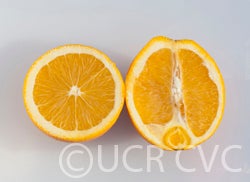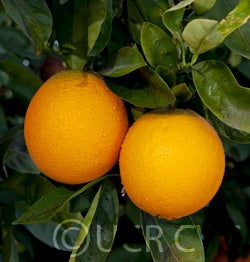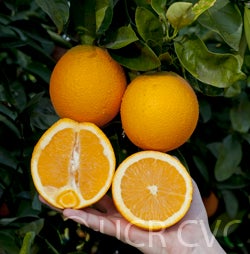Citrus sinensis (L.) Osbeck
CRC 3017
PI 539565
VI 381
Source
Received as budwood from Fay Gillette, Hemet, Ca, 1953.
Parentage/origins
Parents unknown. Probable limb sport.
Rootstocks of accession
Carrizo citrange, C-35 citrange
Season of ripeness at Riverside
December to January
Notes and observations
EMN, 1986: Budwood from State-registered tree No. 2876. Characterized by larger, darker green, coarser leaves than regular navel. Fruit tends to be a little larger and a little coarser than a regular navel. May be a tetraploid. #1 tree planted in 1930 by W.M. Gregg, Rootstock unknown--located in 4th irrigation block, east of flume and east and adjacent to irrigation stand in row 46 last tree in irrigation run. Registered as tree #2876. Progeny trees topworked at Stewart Hinkley, Redlands; also Earl Gillette, LaVerne. #2 Gillette very similar to #1. Located in same block in R-48 and 8th tree from bottom of irrig. run. Registered as tree #2877. This accession had exocortis which was removed by shoot tip grafting (STG 31-1).
Description from The Citrus Industry Vol. 1 (1967)
"Fruit large, spherical; navel well developed but not prominent; seedless. Well-colored. Rind thick and moderately pebbled. Flesh color, texture, and flavor similar to Washington. Very early in maturity (about ten days earlier than Washington) and holds well on the tree.
Tree vigorous and distinctive in appearance; leaves large, thick, cupped, and somewhat grapefruit-like, clustered toward the tips of erect branchlets. Fruit said to be less subject to sunburn and splitting than Washington. Moderately productive.
In comparison with the Washington variety, the fruit of the Gillette is slightly larger and more spherical. The rind is also somewhat thicker. The tree is distinctively different in appearance.
The origin of Gillette is unknown, but it is presumed to be a limb sport that was accidentally propagated about 1935 by the Gregg Nursery of Anaheim, California. It came to light in 1945 when four scattered trees were found in an orchard owned by the Gillette Brothers at Hemet, California, which had been planted in 1936 by the Gregg Nursery. Although not promoted by any nursery company, plantings of this variety now occur in all the more interior navel orange sections of California."
Availability
Commercially available in California through the Citrus Clonal Protection Program. Click here to order budwood.
USDA Germplasm Resources Information Network page for Gillette navel orange
Bibliography
Citrograph 60:433-438, Oct. 1975.



